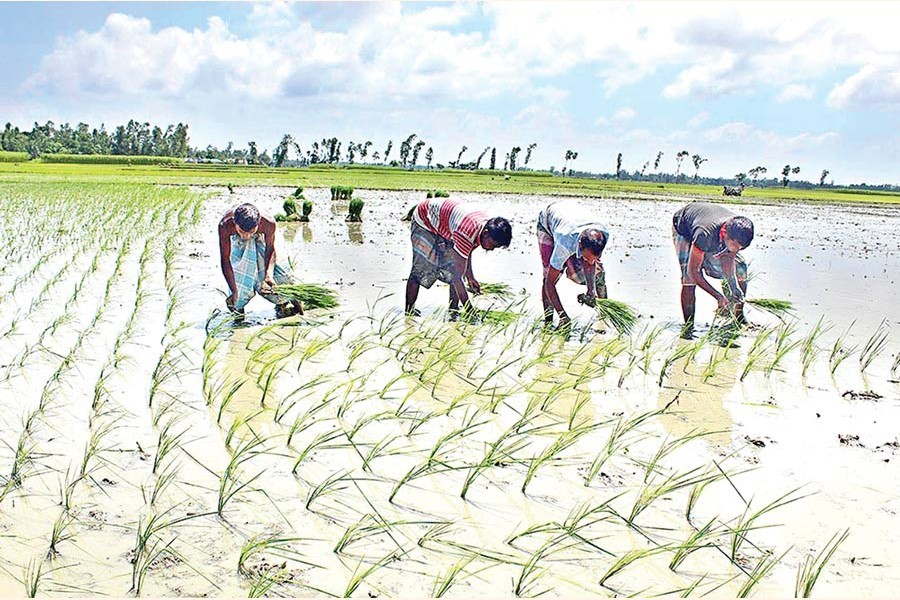
Published :
Updated :

A significant rise in the prices of different agricultural inputs is set to push up Aman plantation costs, especially in 28 flood-hit districts this year, according to experts and farmers.
Aman is the second-largest source of rice comprising 38 per cent of the total production in Bangladesh.
Flood-affected farmers claimed seedling, fertiliser, pesticide and labour costs have surged abnormally this Aman season.
Recent floods have hit hard growers in Gaibandha, Kurigram, Lalmonirhat, Nilphamari, Bogura, Sirajganj, Jamalpur, Faridpur, Madaripur, Shariatpur and several other districts.
The local peasantry was having a scarcity of seedlings as seedbeds in a vast area got damaged by four-week floods between July and August.
"We need seedlings now as floodwaters have almost receded. It will get delayed if we start making seedbeds again," said farmer Shohrab Mandal of Khogakhoribari under Dimla union in Nilphamari.
They are sourcing seedlings from neighbouring villages at high rates.
"A bunch of seedlings of Swarna paddy per decimal was selling at Tk 40-50. It'd cost us Tk 1,200-1,500 per bigha for seeds against Tk 250-300 normally," he said.
Reazul Hoque, a farmer from Gaibandha Sadar sub-district, told the FE that many of them started making seedlings again but seed prices have zoomed up.
Seed varieties like BR-11 and Swarna now sell at Tk 80-120 a kilogram against the usual rates of Tk 38-60.
Bangladesh Agricultural Farm Labour Federation president Zainal Abedin said fertiliser costs are set to rise as bad clay entered croplands during floods.
"Our field reports showed farmers were spreading an additional 8.0 to 10 kg of urea, TSP, MOP and DAP fertilisers per bigha for bad clay."
Local outlets were overcharging Tk 3.0-6.0 a kg for fertiliser against government rates, added Mr Abedin.
Traders were charging higher than normal prices for plough, seed and pesticide banking on floods, he cited.
The overall output cost per bigha is likely to go up by at least 30 per cent in the affected areas.
Meanwhile, most of farmers in Kurigram and Jamalpur districts are yet to go for cultivation amid a dearth of dry places for seedbeds, sources said.
According to the government's agriculture extension department, 0.4 million hectares of farmlands have been affected by floods.
Of the figures, data showed, 0.18 million hectares witnessed total damage. More than 42,000 hectares of seedbeds were totally damaged in the deluge. Countrywide floods marooned 6.07 million people for weeks.
Agriculture extension department director general Mir Nurul Alam said floods could not affect Aman farming on a large scale.
Farmers were then preparing Aman seedbeds, he said, adding that they would transplant seedlings until September.
Mr Alam said the government has started giving seedlings and fertilisers for free to the flood-affected farmers in 28 districts.
However, the government has a target to get 14.5 million tonnes of rice on 5.6 million hectares of land this Aman season.
The official said 55 per cent of the target was achieved till August 22 and plantation would be going on until September.
Alam output was 14.3 million tonnes last year.
Meanwhile, Bangladesh Agricultural Research Foundation chairman Prof Abdul Hamid suggested the government ensure minimum paddy price to salvage farmers from their Boro debacle.
Indirect fertiliser subsidy aside, he said, the affected growers should be given cash incentives which could minimise production costs to some extent.
A fall in Aman production could surge rice prices next year and the government should be cautious about it, Prof Hamid observed.
However, rice prices were almost static for the past two months, according to the Trading Corporation of Bangladesh and the Department of Agricultural Marketing.
Coarse rice was retailing at Tk 30-40, medium quality at Tk 40-50 and finer at Tk 50-65 a kg across the country.
tonmoy.wardad@gmail.com


 For all latest news, follow The Financial Express Google News channel.
For all latest news, follow The Financial Express Google News channel.